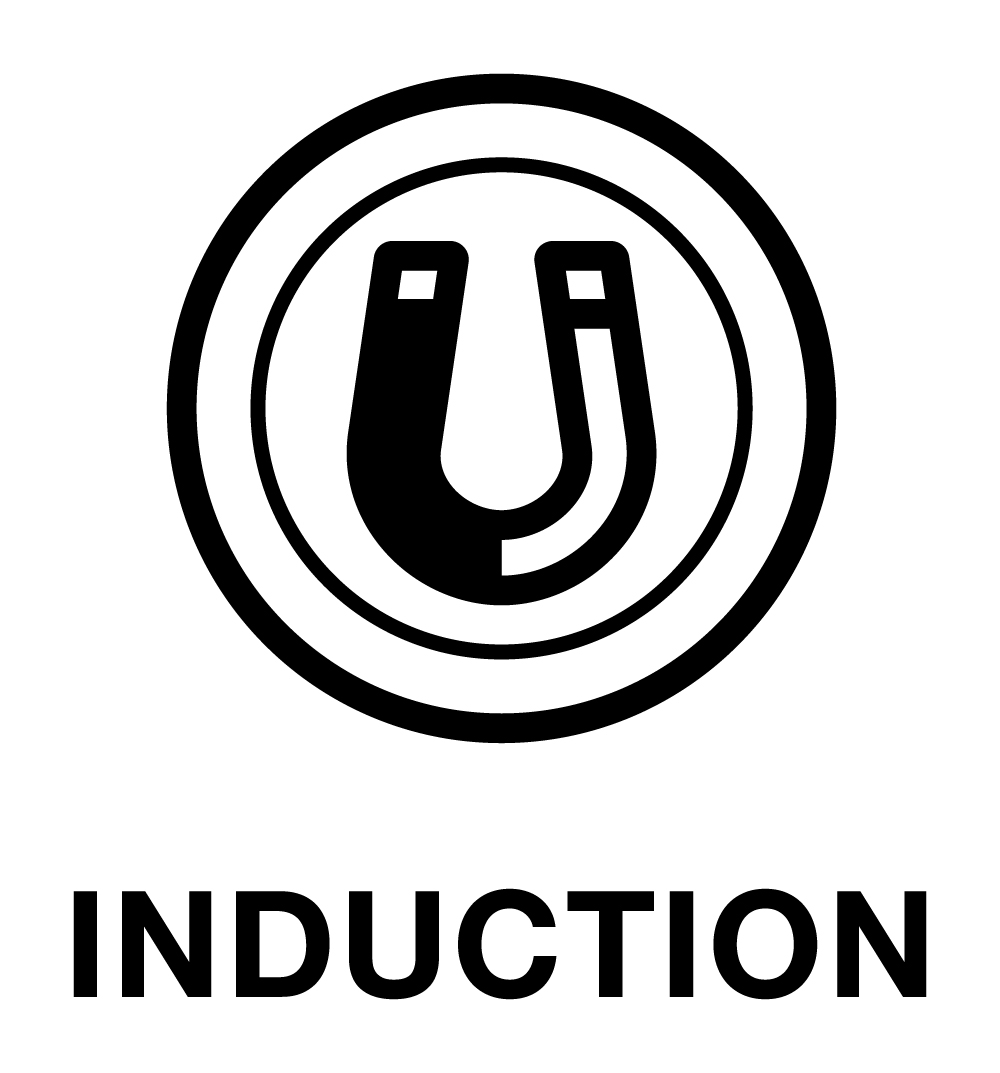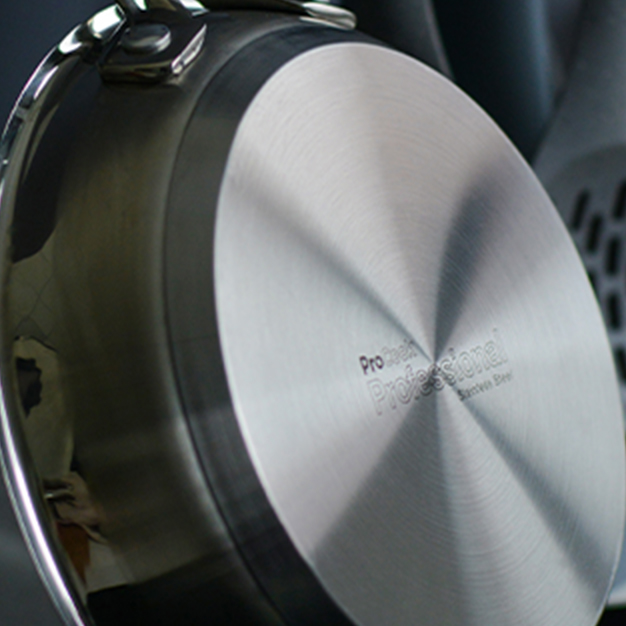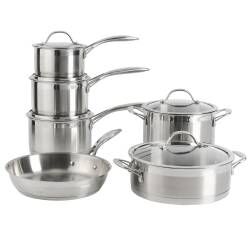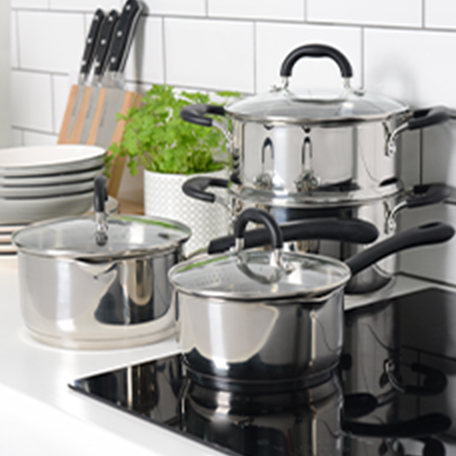ProCook Help Hub
The latest inspiration and advice from the experts at ProCook
Perhaps you're considering the switch to induction but are unsure on which cookware is best for induction cooking and how induction cooking works.
Our handy guide is here to answer all your induction-related questions, so you're ready to buy your first ever induction cookware set.
What is an Induction Hob?
Cooking with induction has become more and more talked about in recent years, with more households making the switch from gas and electric to induction. With their sleek surfaces and modern design that blends effortlessly into almost any kitchen style, it's not surprising. However, an induction hob has much more to offer than good looks. It also offers efficiency and extra precision.
How Does an Induction Hob Work?
Induction hobs have a coil beneath a glass surface that generates an electrical current. The heat is only activated when turned on and induction compatible cookware is placed on top. When non-induction is used, it won't generate any heat or will conduct poorly. Once an induction compatible pan is removed, the induction hob momentarily turns off until the cookware returns, or it is switched off completely.
What Pans Can Be Used on an Induction Hob?
Always check for the induction compatible logo, which is similar to the one shown on the right. A product description is likely to label the pots and pans as induction safe too, so be sure to check there before purchasing.
Not all induction cookware is the same. Some induction pans will be induction-friendly but not fully compatible, meaning the benefits of cooking with induction is lessened. You can usually tell by the pan's base. The base may show dimples instead of a smooth, full base like the ones you find at ProCook.
All cookware sets and single pots and pans at ProCook are crafted for full induction compatibility
, meaning they can be used on all hobs and cooktops.

What are the Benefits of an Induction Hob?
Induction stoves have many advantages that can transform your way of cooking and lifestyle. Whether you’re looking for more efficient cooking methods or modern design, here are a few core advantages of an induction hob.
1. Quick Heat Up
Your induction hob isn't going to heat up unless there's induction optimised cookware on top. However, this direct transfer of heat that travels from the hob's coils to your pan is incredibly fast and heats up much quicker than electric or gas hobs.
2. Responsive Temperature Control
Greater temperature control means you can cook more precisely and consistently. Once you've set your chosen temperature, your pan self-regulates, meaning you can add cold foods without worrying about needing to counter this drop in temperature - your induction hob will do this for you.
3. Precise Cooking
By having such a responsive temperature control, you can enjoy more precise cooking. Better temperature control allows you to deliver more consistent cooking results, so you can serve up delicious food time and time again.
4. Energy Saving
A reduced heating time makes induction cooking much more efficient, lessening energy usage and energy wastage when cooking. What’s more, all heat is channelled directly into your induction-friendly cooking equipment, meaning less power is used to cook your food.
5. Easy to Clean
Their smooth, flat surface make them incredibly easy to clean. Wipe down your induction hob after each use to stop build up of grime and food splatters.
6. Increased Safety
Although an induction cooktop doesn’t heat up itself, the surface does become warm from the residual heat transmitted from the cooking pans. This makes induction hobs much safer, as there’s less chance of burning yourself or catching tea towels on fire. While the induction hob does not become hot, it can become warm from transferable heat radiating from the used cookware. Please remember that induction cookware does become warm and should be used and handled carefully.
Induction stovetops sense when cookware is removed and momentarily turns off until the cookware is placed back on top. Always remember to turn an induction hob off by the source once you’re done cooking.
Energy Saving Tips with Induction Cooking
Although induction cooking supplies faster heating, improved thermal efficiency and more consistent heating than other cooking methods, there are other steps that can be taken to increase your energy saving.
1. Match the Pan Size with the Size of the Hob
Using a pan that is too big or too small can impact the amount of energy needed to heat up the cookware. A pan that is too big and overlapping your hob requires more heat (and energy); it can also produce uneven cooking results. Furthermore, using a pan that's much smaller than your hob creates a weaker magnetic field and reduced heat output.
2. Cook with a Lid Where Possible
If able to, adding a lid can improve the cooking speed by trapping heat. If you can't cook with a lid on, you can turn off the induction hob a few minutes before serving, place the lid on top, and allow the ingredients to continue cooking.
3. Keep Your Cookware Clean
Build-up of food, grime, grease, or blackened surfaces can influence the effectiveness of induction cooking. Keep the bottom of your cookware clean to ensure the induction process is as effective as possible.
Induction hobs can be considered safer than gas or electric as they do not emit gas fumes into the air and won’t cause objects like tea towels to catch fire. This is because induction hobs only heat items that conduct.
While there is greater safety when cooking with induction, please be careful when handling pans as they will still become hot to the touch.
Is Induction Cooking Safe?




 Electricals
Electricals
 Coffee
Coffee
 Mixers and Blenders
Mixers and Blenders
 Kettles and Toasters
Kettles and Toasters
 Cooking
Cooking
 Small Appliances
Small Appliances
 Cookware & Bakeware
Cookware & Bakeware
 Pots and Pans
Pots and Pans
 Speciality Cookware
Speciality Cookware
 Baking
Baking
 Roasting
Roasting
 Knives
Knives
 Knife Sets
Knife Sets
 Single Knives
Single Knives
 Knife Accessories
Knife Accessories
 Tableware
Tableware
 Single Items
Single Items
 Serveware
Serveware
 Table Accessories
Table Accessories
 Outdoor Dining
Outdoor Dining
 Drinkware
Drinkware
 Hot Drinkware
Hot Drinkware
 Cafetieres and Teapots
Cafetieres and Teapots
 Drink Accessories
Drink Accessories
 Accessories
Accessories
 Kitchen Utensils
Kitchen Utensils
 Tools and Gadgets
Tools and Gadgets
 Storage
Storage
 Cleaning
Cleaning
 Summer desserts and baking
Summer desserts and baking
 Offers
Offers
 Gifting
Gifting


